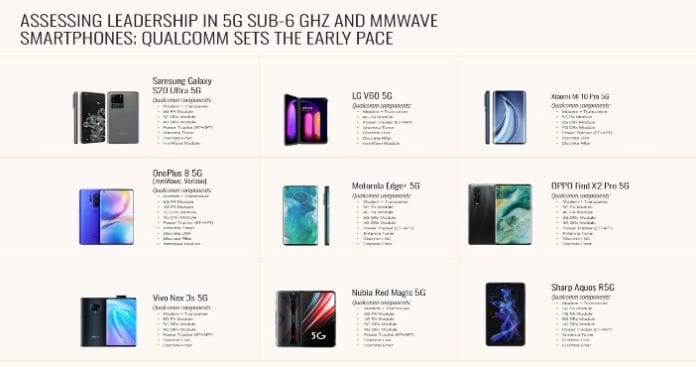The 5G smartphone market is set to rapidly expand in the next 12 months, with many mobile vendors looking to quickly develop their 5G portfolios. It is anticipated that 5G will increase more aggressively compared to 4G to become the most accelerated mobile technology generation ever launched, despite any lag in demand that may be caused by the outbreak of COVID-19 and the ongoing U.S.-China trade dispute. This landmark growth includes a seismic shift to make the new technology available across price tiers, which will greatly increase the global addressable market for 5G.
However, While smartphone OEMs once relied heavily on chipset suppliers to help design high-performance systems, the move to 5G requires integration of the entire 5G cellular system design into their devices, from modem-to-antenna, addressing all aspects of end-to-end performance. This level of complexity includes the integration and deployment of new 5G modem and RF Front-End (RFFE) components, features, and functionalities, leading to substantial changes in the design of mobile devices. The RFFE, in particular, is encountering some huge challenges as the related discrete components expand exponentially with the addition of new 5G spectrum bands, as well as integration of corresponding RF features, such as global 5G support, 5G/4G E-UTRAN New Radio-Dual Connectivity (EN-DC), Carrier Aggregation (CA), Dynamic Spectrum Sharing (DSS), downlink and uplink Multiple Input, Multiple Output (MIMO), dynamic antenna tuning, beamforming, and envelope tracking.
Smartphone OEMs are finding this change particularly challenging, as it makes their RFFE component procurement process and system design far more complex than ever. Unless adequately addressed, the burden brought about by the complexities of implementing 5G can lead to several issues, namely:
- Lengthy product development cycles
- Performance gaps
- More expensive devices
- Huge constraints on device industrial designs
- Increased power consumption
- Additional costs Stock Keeping Unit (SKU) fragmentation
- Limited or no support for mmWave
To help suppress this complexity, while also maximizing device performance, many mobile RF component players need to achieve higher levels of miniaturization, integration, and performance to ensure that 5G can flourish unhindered for everyone along the value chain. It is here that the use of RFFE modules and help from end-to-end specialized RF solutions providers can offer welcome support to OEMs. This approach will help greatly with the entire cellular system design from modem-to-antenna. By implementing these high-end RFFE solutions, OEMs’ product assembly processes are made far simpler and they will not need to deal with a proliferation of future component types and suppliers. For the OEM, this will enable them to give greater attention to the following:
- Focus on device customer experiences
- Speed time to market
- Concentrate on smartphone design
- Deliver more reliable products with the required scale and availability
To achieve this goal, OEMs will have to rationalize the delegation of modem-RF system procurement to a handful of suppliers and, most importantly, make sure they pick the right partner. Notably, it needs to be one with a comprehensive, rich RFFE portfolio and a comprehensive 5G roadmap. The delegation brings with it several advantages, many of which have become increasingly stark as the device market transitions to 5G. Among the most critical advantages of this approach are:
- System-Level Integration: Helps maximize system performance, while lowering power consumption compared to assembling various RF components from multiple vendors.
- Technology Complexity: This is taken out of the OEMs’ hands so they can focus on offering better experiences to end customers, concentrating on industrial design and User Interface (UI).
- Accelerates Time to Market: Time to market is important for smartphone segments submitting to rapid product intro cycles.
- Accelerates Adoption of New 5G Features and Functionalities: Enables OEMs to accelerate 5G adoption to remain competitive and relevant in this fast-moving market landscape.
- Cost Advantage: Enables a level of cost advantage when the modem-RF system is adopted on a large scale.
- Simplify Component Sourcing: Helps the process, as OEMs need to deal with far few suppliers or, ideally, just one vendor.
Ultimately, a highly integrated system-level design is the key to success as the market moves to 5G. There are already signs that several OEMs are moving away from RF component assembly and adopting 5G design from modem-to-antenna. Such a strategic approach has been carried out by few component suppliers in the market, thus far, and Qualcomm is currently the only one able to offer an end-to-end product portfolio from modem-to-antenna, supplying products with end-to-end performance in fully integrated system designs. However, it is expected that third-party modem-RF system design will become a mainstream approach in support of many of the world’s top smartphone OEMs to solve their 5G conundrum, so Qualcomm is likely to be joined by others if they are able to offer such turnkey solutions.
Figure 1: Assessing Leadership in 5G Sub-6 GHz and mmWave Smartphones; Qualcomm Sets the Early Pace

For more information on this subject, check out the whitepaper “5G Teardowns Reveal Qualcomm’s RF Leadership Due to Growing Design Complexity”
About David McQueen:
David McQueen, Research Director, manages ABI Research’s connected consumer devices and platforms market coverage, which includes data, trend, and forecast analyses on mobile handsets, smartphones, wearables, accessories, new mobile technologies, and semiconductors. With more than 20 years’ experience in delivering high-value, strategic analyses within mobile telcos, David is well-versed in all technical aspects of telecom technology, including networks, components, software platforms, and ecosystems.
About ABI Research:
ABI Research provides strategic guidance to visionaries, delivering actionable intelligence on the transformative technologies that are dramatically reshaping industries, economies, and workforces across the world. ABI Research’s global team of analysts publish groundbreaking studies often years ahead of other technology advisory firms, empowering our clients to stay ahead of their markets and their competitors.

